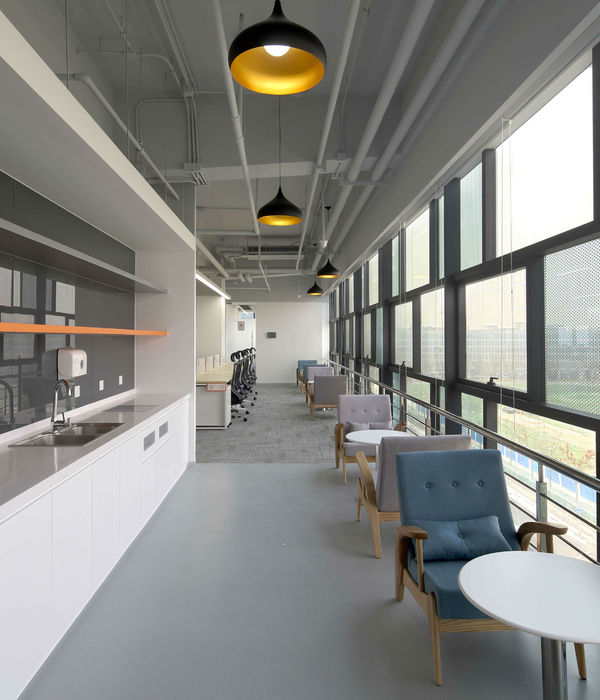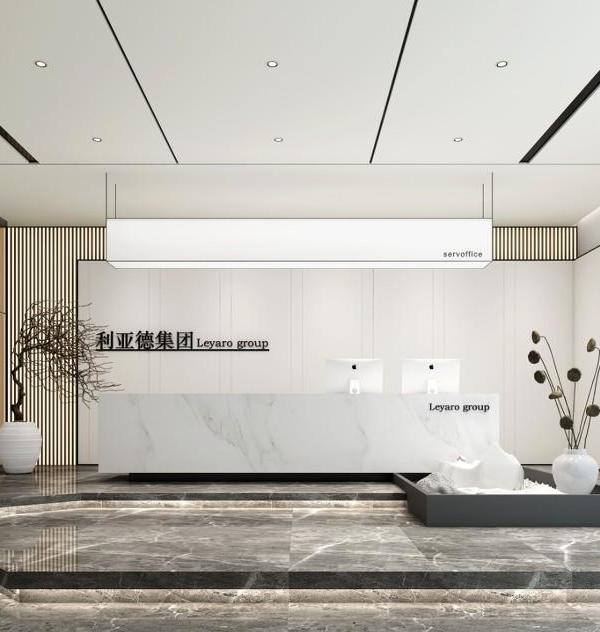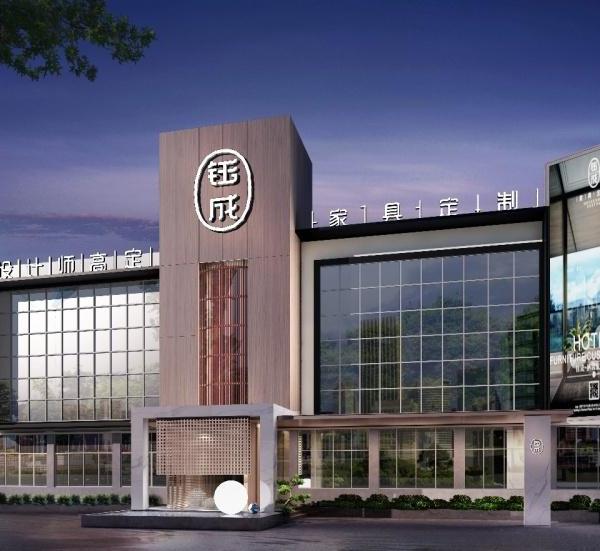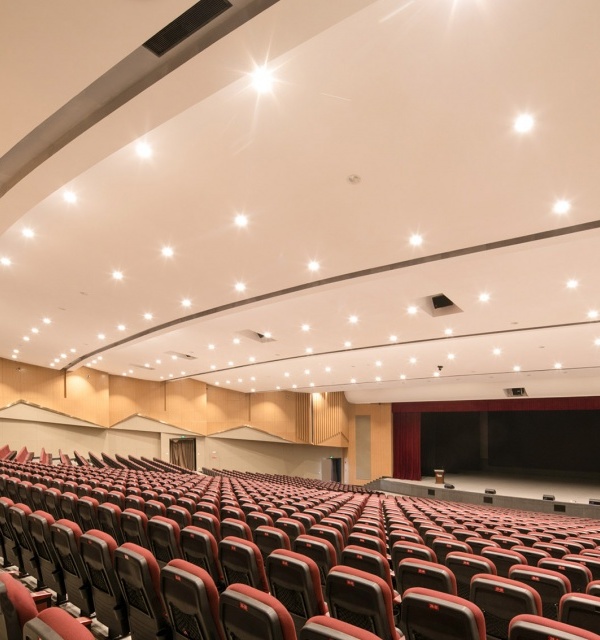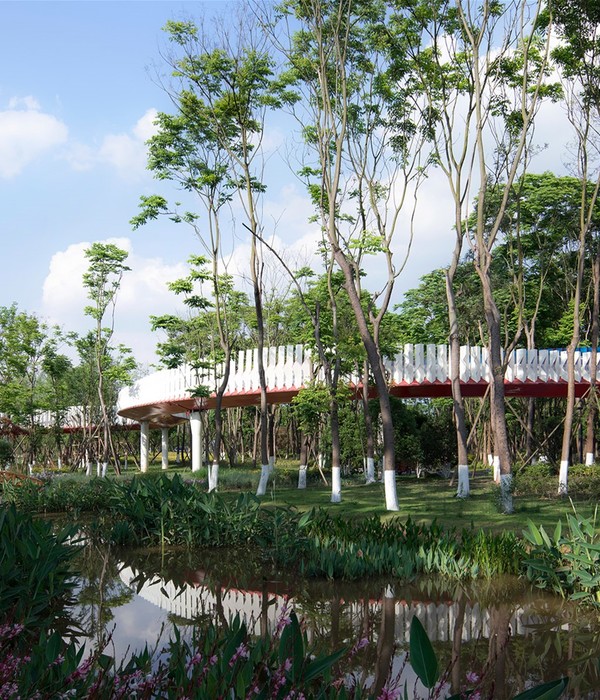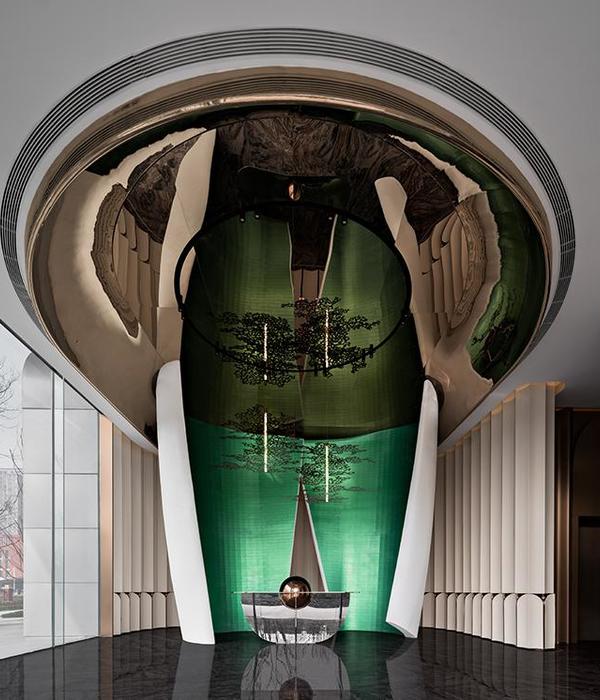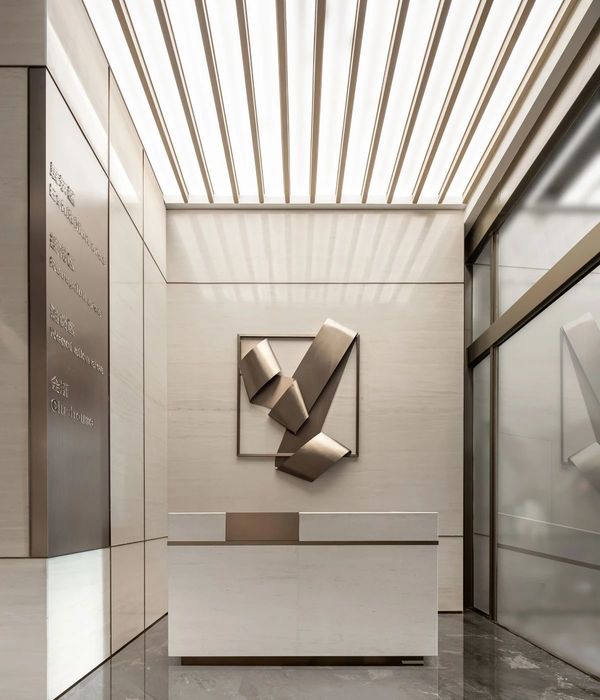徽派语言与建筑尺度
Hui-Style Language and Architecture Scale
宣城地处安徽省的东南部,以宣纸最为文明,下辖县绩溪,是古徽州六县之一;校园整体风格为带有徽派建筑色彩的现代建筑,而徽派的建筑语言与现代大型教学建筑尺度之间的矛盾便成为这次设计任务中最主要的考量。
Xuancheng is located in the southeastern part of Anhui Province and the most famous thing in the area is the Xuan Paper. It has jurisdiction over Jixi County and it is one of the six counties in ancient Hui-Style.;The overall style of the campus is a modern building with Hui-Style architectural color, and the contradiction between the Hui-Style architectural language and the modern large-scale teaching building scale is the most important consideration in this design task.
▼教学楼外观,external view of the building
二期教学楼,又名新安学堂,位于整个校区的东北部,东侧毗邻学生生活区,总建筑面积36750平方米,比一期更大,试图通过体块的组合化解过大的建筑体量,获得更为宜人的建筑尺度。
The second-phase school building, also known as Xin’an School, is located in the northeast of the entire campus and is adjacent to the student’s living area to the east. It has a total construction area of 36,750 square meters, which is larger than the previous period. It tries to solve the problem of large building masses through the combination of body masses to obtain a more pleasant architectural scale.
▼建筑鸟瞰,bird view of the building
形式层面上徽派文化符号的探索
An Exploration of the Cultural Symbols of Hui-Style Architecture on Form
传统的徽州民居以内天井作为主要空间组合单元,这其中有采光通风的需要,也有古徽州人聚水聚财的吉利。将这种紧凑的布局应用在现代教学建筑上,不但可以解决相对紧张的用地需求,还可以形成一个个较为安静的内院,创造出合适读书学习的环境;二期教学楼项目按照采光通风的要求以南北向为主,东西向为辅串联成四个的庭院;北侧的三个庭院,南北向以大教室为主,东西向辅以小教室或走廊,形成三个较为封闭但形态尺度略有不同的三个院落;西南边的庭院呈U字型向西侧的广场打开,向西面一期教学楼 呈欢迎之势,引导中心广场的人流进入建筑内部,作为整个建筑的主要出入口。
The traditional Hui-Style dwellings have the courtyard as the main space combination unit. Among these are the need for lighting and ventilation, and also the auspiciousness of ancient Hui-Style people gathering water and gathering wealth. Applying this kind of compact layout to modern teaching buildings can not only solve the relatively tense demand for land, but also form a relatively quiet inner courtyard to create a suitable environment for reading and learning;The second-phase teaching building project is based on the requirements of lighting and ventilation in the north-south direction, and the east-west direction is supplemented by four courtyards. There are three courtyards with slightly different three degrees on the north side; the U-shaped courtyard on the southwest side is open on the west side of the courtyard; the teaching building on the west side shows a welcome trend and guides the flow of people from the central square into the interior of the building. The main entrance to the entire building.
▼项目概况,Project Overview
从屋顶上看去,四个庭院通过屋面坡屋顶连续的S型组合串联在一起,每个庭院三边坡屋顶,一边平屋顶,三边坡屋顶均按照四水归堂的原则坡向内庭。
Seen from the roof, the four courtyards are connected in series through a continuous S-shaped combination of roof sloping roofs. Each courtyard has three sloping roofs, one flat roof, and three sloping roofs are all sloped toward the inner courtyard in accordance with the principles of the Four Waters Returning House.
▼二期教学楼俯视平面图,Aerial view of the general plane of the second period teaching building
西立面的廊道是对内天井传统街巷的另一种解读。这里的街巷空间不再仅仅是水平向的交错,而是利用台阶和廊桥立体的展开,满足疏散要求的同时,更好的服务于教学功能空间。
The Western Corridor Corridor is another Interpretation to the traditional Street of Inner Patio. The street space here is no longer merely the horizontal staggering, but also three-dimensional development of the steps and the corridor bridge, meeting the evacuation requirements, and better serving the teaching function space.
▼从西侧广场看教学楼,view of school building from the west square
廊道内,一侧为半透明镂空的青砖花格墙,一侧是相对较实的走廊山墙,又有廊桥横跨其中。每当黄昏降临,落日的余晖肆意散落在青石台阶和黛青色的山墙上,使徽州学子们更深切地体会到熟悉的徽韵,徽味。
Inside the gallery, one side is a semi-transparent hollow brick lattice wall, the other side is a relatively solid corridor gable, and aerial corridor bridge spans it. When dusk comes, the setting sun is strewn with blue stone steps and blue green walls, making Hui-Style students feel more familiar with the familiar rhyme and Hui-Style.
▼教学楼西侧主入口,Main entrance on the west side of the school building
▼傍晚时分的西侧廊道,Western Corridor in the evening
“徽”符号,马头墙坡屋顶
Crest” symbol, horse head wall slope roof
层层叠叠的马头墙和坡屋顶的组合无疑是最具代表性的徽派符号,两者一黑一白,一直一斜,马头墙的跌落又呼应了斜线坡屋顶,再配以民居2~3层的建筑,尺度和谐,完美互动; 针对这次现代大体量的教学建筑,设计时果断放弃了简单的模仿这种“徽”符号。在利用这种山墙面与坡屋顶组合基础上,结合西立面的走廊,用连续的坡屋顶创造出一条连续起伏的折线屋面,与西立面平直的山墙形成对比,在更大的尺度上运用传统的徽派符号创新性的实现了另外一种组合的可能。
The combination of stacked walls of horse heads and sloping roofs is undoubtedly the most representative symbol of the Hui-Style. One is black and one is white .One is flat and one is oblique.The drop of the horse head wall echoes the sloping sloping roof. The residential buildings on the 2nd and 3rd floors are harmonious and perfectly interactive.; In response to this modern teaching building, the design time was resolutely abandoning the simple imitation of this “Hui-Style” symbol. Based on this combination of gable and sloped roofs, combined with the corridors of the west facade, a continuous sloping roof is used to create a continuous, undulating, sinuous roof, in contrast to the straight gables on the west facade, on a larger scale. On the scale, the use of traditional Hui-Style symbols has innovatively realized the possibility of another combination.
▼转译后的马头墙与坡屋顶,Translated Horsehead Wall and Slope Roof
“徽”色彩,粉墙黛瓦
Hui-Style” color, pink wall tile
粉墙黛瓦是传统徽派建筑最具有标志性的色彩搭配方式。大面积垂直的墙面以白色为主,而顶部小面积则采用黑色的瓦屋面;二期教学楼的设计中,保留传统建筑朴实的色彩基调,但并不是机械的去复制粉墙和黛瓦。将普通教室的大面积墙体定为黑色长条砖,东西向斜线小体量阶梯教室侧墙采用白色质感喷涂,屋顶沿用小青瓦,局部挑板和矮墙也做白色喷涂。虽然不是完全的粉墙黛瓦,但却在新的功能和尺度下,对传统建筑色彩元素的一种创新,一种发扬。
The pink wall tile is the most symbolic color matching method of traditional Hui-Style architecture. Large vertical white walls are dominated by white walls, while black tile roofs are used in small areas at the top. In the design of the second-period teaching building, the simple color tone of the traditional architecture was preserved, but it doesn’t bluntly copy the walls and the tiles. The large walls of common classrooms are defined as black long bricks, and the side walls of east-west slash small volume classrooms are coated with white texture. The roofs are made of small green tiles. Partial picks and low walls are also painted white. Although it is not a complete wall, but an innovation of traditional architectural color elements, a kind of development in the view of new function and scale.
▼东侧阶梯课室立面,Eastern Ladder Classroom Façade
▼花格窗立面,Lattice window facade
内在秩序的徽派精神
The Hui-Style spirit of inner order
“古徽州尊重山水等自然地貌,建筑融汇于山水之间”。本项目的基地北高南低,在规划设计上保留原有地形信息,将建筑由南向北分别坐落在三个不同的标高上,连续的体量因山就势,蜿蜒而上,仿佛栖息生长在原有的地形上,有效地呼应了地形,也形成了自身的特色。
The ancient Hui-Style respected natural landscapes such as landscapes, and the buildings were blended between landscapes”. The base of the project is high in the north and low in the south. It retains the original topographical information in the planning and design. The buildings are located at three different elevations from south to north. The continuous volume is like a mountain, a squat, and seems to be perched. Growing on the original terrain effectively responded to the terrain and formed its own characteristics.
▼剖透视图,建筑因势随形,perspective section shows that the building follows the topography
校园内的建筑从大门开始,反复使用了徽派建筑的典型符号牌坊,但在校园总体规划上,新安学堂并不在校园的主要轴线上,所以主动放弃了这一最具徽文化特色的建筑符号;仅在西侧主广场处设一巨大尺度的斜线坡屋顶的灰空间,将人流引入其内。这种低调的做法,也正符合徽文化中 “追求伦理化的审美秩序,讲究整体秩序、主次分列、等级分明,长幼有序”。
The building on campus starts from the gate and repeatedly uses the typical symbol arch of Hui-Style architecture. However, in the overall campus planning, Xin’an School is not on the main axis of the campus, so it has given up this architectural symbol of the most Hui-Style culture; Only a large-scale sloping sloping roof ash space is set up on the west side of the main plaza to introduce pedestrian traffic. This low-key approach is also in line with the “ethical culture that values ethics” in the Hui culture, “pursuing an ethical aesthetic order, stressing the overall order, ranking primary and secondary, ranking clearly, and being orderly in age”.
▼灰空间将人引入,gray space attracts people into the building
建筑形体组合的徽文化特质
The characteristics of the Hui-Style culture of building combination
在建筑平面上将教学楼的主体用高墙包裹,营造封闭,内向,独立,安静的主体教学空间,传承了徽派文化的特质,也符合现代教学楼对课室功能相对安静的要求; 以高墙为背景,低矮的大课室在起伏连续坡屋顶下成为建筑展示给校园环境的主体。新安学堂用高墙将大部分教室用房藏在南北向并置的四个庭院内,使得外部连续坡屋顶获得更接近徽派建筑的宜人尺度,和风格统一、连续整体的立面。
On the architectural plane, the main part of the teaching building is wrapped with a high wall to create a closed, inward, independent and quiet main teaching space, which inherits the characteristics of the Hui-Style culture and also meets the relatively quiet requirements of the modern teaching building; Against the backdrop of a high wall, the low and large classrooms under the undulating continuous slope roof became the main body of the building to be displayed to the campus environment. The Xin’an School uses high walls to store most of its classroom buildings in four courtyards juxtaposed in a north-south direction. This allows the external continuous-slope roofs to acquire a pleasant scale that is closer to the Hui-Style architecture and a style that is uniform and continuous.
▼高墙后封闭安静的公共空间和教室,closed and tranquil public space and classrooms behind the high wall
装饰上的徽精神
The Hui-Style spirit on the Decoration
精雕细作的徽派工匠精神,结合东西侧主要交通空间遮阳的需求,在折线屋顶侧墙采用砖砌花格窗,满足通风和必要的采光。半透明的表皮使得交通空间与西侧的广场产生了特殊的关系,空间上又彼此独立,景观上相互渗透,夕阳西下,花格墙的倒影肆意的洒在台阶廊道内,形成教学楼内最为独特的交往空间。
The carefully crafted Hui-Style craftsman spirit combines the shade of the main traffic space on the east side and the west side of the zigzag roof with brick lattice windows to meet ventilation and necessary lighting.The translucent skin makes the traffic space have a special relationship with the square on the west side. The space is independent of each other. The landscape penetrates each other and the sun sets. The reflection of the lattice wall is sprinkled in the corridor on the stairs to form a teaching building. The most unique interaction space.
▼不同纹理的花格砖墙创造独特的交往空间,lattice wall with various patterns creates unique interaction space
▼总平面图,site plan
▼标高-4.500m平面图,Elevation – 4.500m floor plan / 标高±0.000m平面图, Elevation ±0.000m floor plan
▼标高4.500m平面图,Elevation4.500m floor plan / 标高9.000m平面图,Elevation9.000m floor plan
▼标高13.500m平面图, Elevation 13.500m floor plan / 标高18.000m平面图 ,Elevation18.000m floor plan
▼立面图,Elevation
▼剖面图,Section
项目概况
项目名称:合肥工业大学宣城二期教学楼
设计单位:华南理工大学建筑设计研究院
设计团队:陶郅、谌珂、郭钦恩、涂悦、陈韬、孙传伟、赖洪涛、黄晓峰、岑洪金等(排名不分先后)
建设地址:安徽省宣城市
总建筑面积:36 750 平方米
设计 / 竣工时间:2012年 / 2014年
图片来源:项目组
曾获奖项
第八届中国威海国际建筑设计大奖赛优秀奖
2017年度广东省优秀勘察设计奖公共建筑一等奖
2017年度全国优秀工程勘察设计一等奖
Project Overview
Project Name: Xuancheng Phase II Teaching Building, Hefei University of Technology
Design Unit: Architectural Design and Research Institute, South China University of Technology
Design Team: Tao zhi, Chen Ke, Guo Qinen, Tu Yue, Chen Hao, Sun Chuanwei, Lai Hongtao, Huang Xiaofeng, Yan Hongjin, etc. (in no particular order)
Construction address: Xuancheng, Anhui Province
Gross floor area: 36,750 square meters
Design / Completion time: 2012 / 2014
Image Source: Project Team
Awarded
The 8th China Weihai International Architectural Design Awards Excellence Award
The First Prize of Public Building in Guangdong Province for Excellent Survey and Design Award 2017
2017 First National Excellent Engineering Survey and Design Award
{{item.text_origin}}

